Insurance
65% of Americans Have a Smart Home Device, Especially Those Concerned About Climate Change
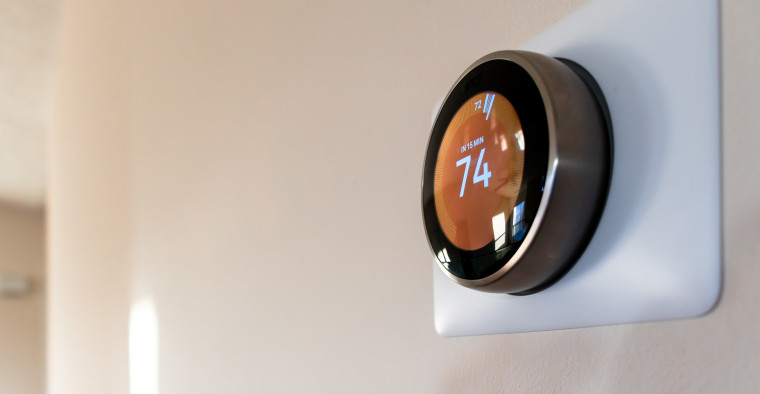
With technology continuing to advance and optimize little parts of life, smart home devices are continuing to gain popularity across homes in the United States. ValuePenguin surveyed more than 1,000 individuals and found that smart home devices are increasingly common, and owning one seems to have a correlation with being concerned about climate change.
Our research shows that 65% of Americans have a smart device in their home, and for a variety of reasons. Those concerned with the environment are purchasing smart home devices at a faster rate. The survey also shows that men tend to embrace smart home technology at higher rates than women, and those in the Northeast have smart devices more often than their Midwest counterparts.
Key findings
- Sixty-five percent of Americans have at least one smart home device, and many purchased the smart technology because it’s better for the environment. The most popular smart home devices among our respondents included speakers (31%), thermostats (24%) and lighting (20%).
- Men embrace smart home technology at much higher rates than women. Eighty-two percent of men have a smart home device versus 49% of women. Also, 71% of men are considering purchasing another smart home device in the next six months versus 34% of women.
- There is a strong correlation between climate change concerns and interest in smart home technology. Seventy-four percent of those who are very concerned about climate change have a smart home device versus 58% who are somewhat concerned and 42% who are not that concerned.
- Northeast residents are most likely to have smart home technology, while those in the Midwest are least likely. Northeasterners also reported the most concern about climate change.
Smart home devices are on the rise, especially among environmentalists
According to our survey, 65% of Americans own at least one smart home device. They include:

Of the people who own a smart device, 49% have a smart home device that could be considered environmentally friendly. These include a smart thermostat/AC, lighting, kitchen appliances, plugs/outlets, vacuums and sprinklers.
The devices listed above help users find ideal settings for activities that normally use a lot of resources, such as electricity, gas and water. These smart devices help limit power usage while allowing users to customize their settings and creating a more efficient home.
The desire to use as few resources as possible without sacrificing one's quality of life has culminated in these smart home devices, as 74% of those who are very concerned about climate change have a smart home device. This number is staggering compared to the 58% of people who are only somewhat concerned with climate change and the 42% of people who don’t have a concern.
Focusing specifically on the eco-friendly devices:
- Smart thermostat/AC: Thirty-two percent who are very concerned about climate change have one versus 14% who are somewhat or not concerned about climate change.
- Smart lighting: Twenty-five percent who are very concerned have one versus 16% who are somewhat concerned and 6% who are not concerned.
- Smart kitchen appliances: Twenty-one percent who are very concerned have one versus 13% who are somewhat concerned and 7% who are not concerned.
- Smart plug/outlet: Seventeen percent who are very concerned have one versus 12% who are somewhat concerned and 5% who are not concerned.
- Smart sprinkler: Twelve percent who are very concerned have one versus 5% who are somewhat concerned and 0% who are not concerned.
Our survey shows that 52% of those who are very concerned about climate change and have a smart home device said they purchased that device because it’s better for the environment, versus 20% of those who are somewhat concerned and 10% who are not that concerned.
Also, 66% of those very concerned about climate change plan to buy another smart home device in the next six months. When compared to other respondents, only 41% seemed somewhat concerned and 20% were not concerned at all, showing that those concerned with the environment are more likely to be repeat customers of smart home devices.
Men, Generation Xers and Northeasterners are most likely to have smart technology at home
Respondents showed that certain demographics in the U.S. are more likely to own a smart home device. Men, those in Generation X and those living in the Northeast dominate smart device ownership.
According to our survey, 82% of men have a smart home device versus 49% of women. Also, 71% of men are considering purchasing another smart home device in the next six months versus 34% of women, showing that men tend to be more frequent consumers of smart home devices.
When looking at different age groups, Gen Xers were the most likely to own a smart home device at 90%. This was followed closely by nearly three-quarters of millennials who are smart home device owners. Older generations were the least likely to be interested in smart technology with only 39% of baby boomers and 33% of silent generation respondents owning smart home devices.
Of those living in the Northeast, 74% have a smart home device versus 68% of people living in the South, 61% of those living in the West and 54% of those living in the Midwest. Those living in the Northeast were also most likely to say they’d be willing to pay more for smart devices in order to be more eco-friendly.
Overall, climate change concerns can be seen as correlated with having a smart home device. Men were more concerned about climate change than women, Gen X more than any other generation and the Northeast more than any other region.
Consumers are willing to sacrifice data privacy and higher costs for environmental benefits
While smart technology offers a plethora of benefits, there are drawbacks in terms of the prices of such devices, as well as concerns of privacy. However, our survey shows that many respondents are more than willing to accept those trade-offs.
In total, 49% of consumers said they would be willing to pay more for smart home devices in order to be more environmentally friendly.
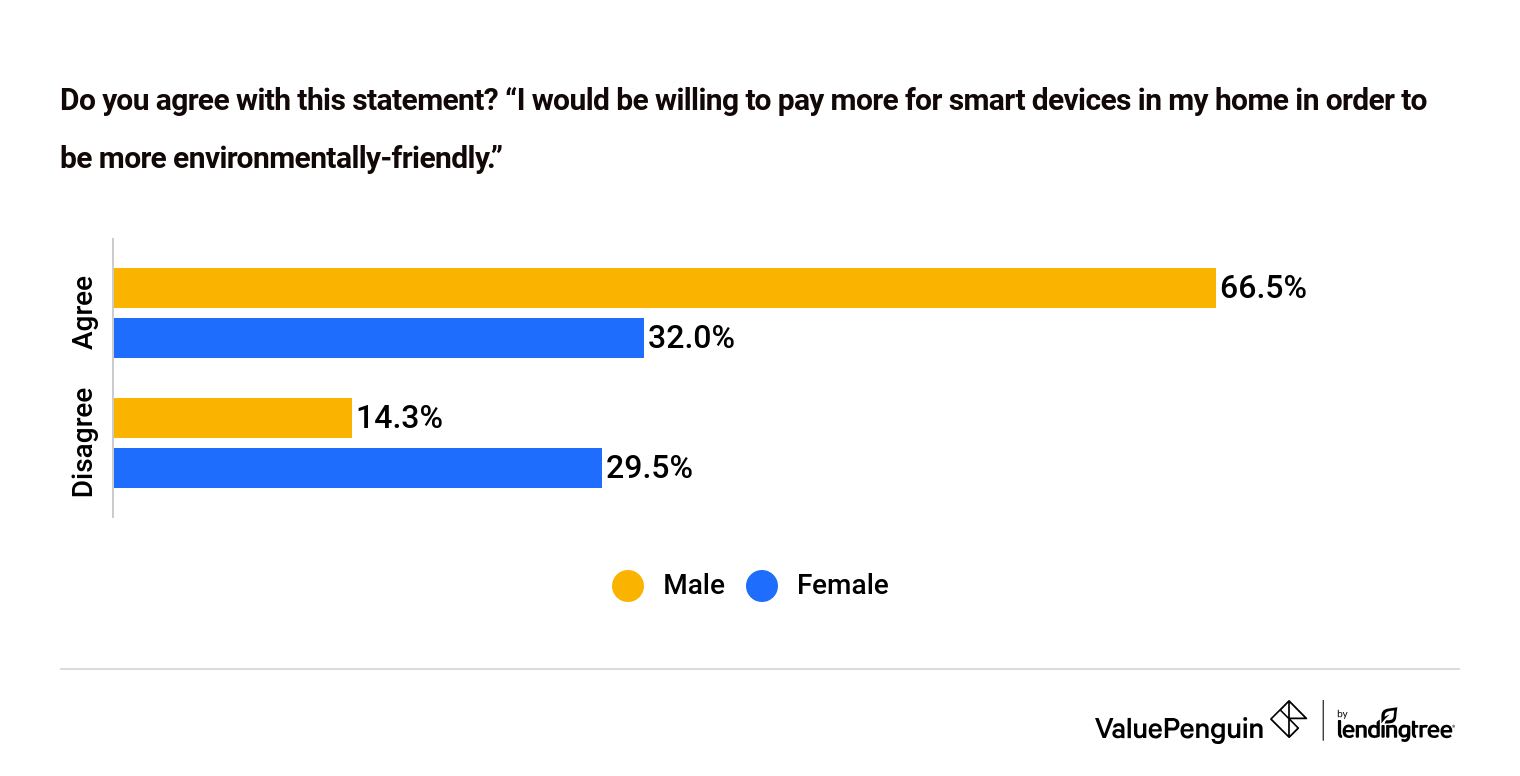
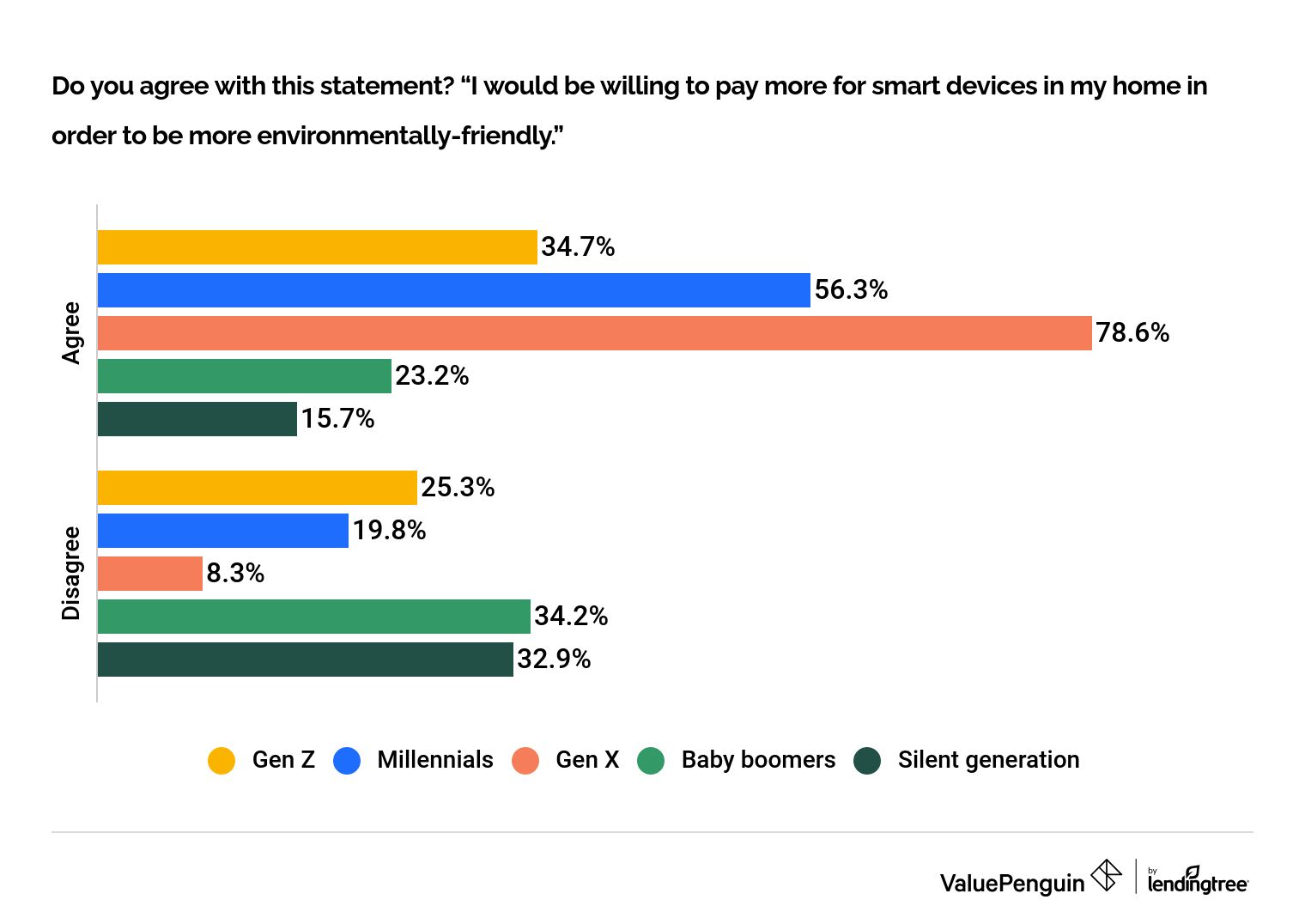
Our research shows that 67% of men versus 32% of women would be willing to spend the extra dollar on smart home technology as a trade-off for a better environment.
Furthermore, the data indicates that Generation X is the most willing generation in terms of spending more on smart home devices while being conscious of climate change. On the other hand, only 16% of the silent generation would be willing to spend more money on smart home devices for the benefit of the environment.
Additionally, 45% of consumers said the environmental and cost benefits of smart home devices outweigh concerns about data privacy.
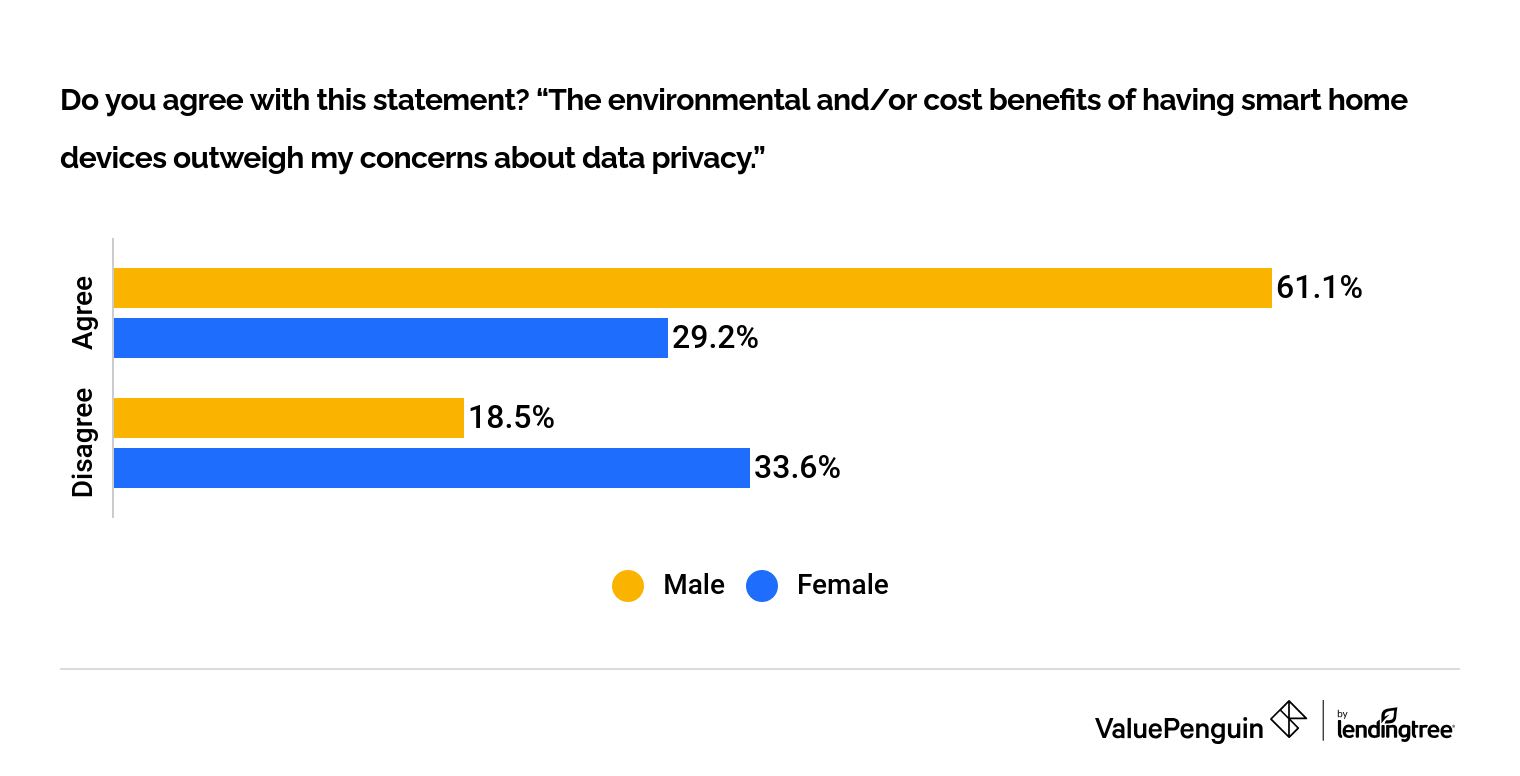
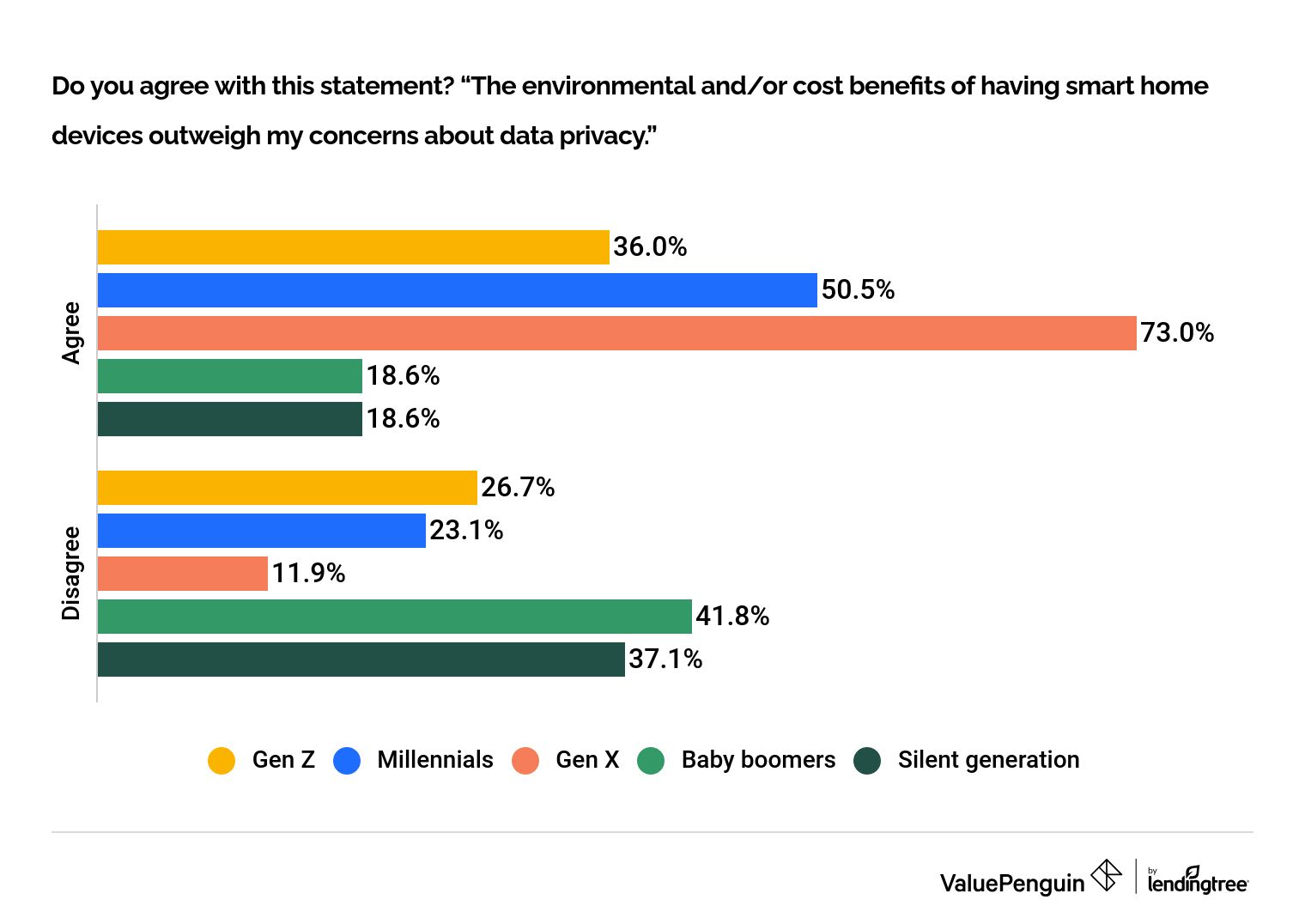
Similar to the data found on consumers willing to spend more on smart home devices for the sake of the environment, men and those in Generation X show the most acceptance of data privacy issues, as they feel the pros of smart home devices outweigh the cons.
Of those who are very concerned about climate change, 59% stated that the environmental and lifestyle benefits of smart home devices are greater than their concerns of data and privacy issues versus 36% of people who are somewhat concerned about climate change and 7% of those who are not concerned.
Insurance discounts for smart home technology
Of all the survey respondents, 56% said they would be willing to purchase and install smart home technology in order to receive a discount on their insurance. Although not all smart home devices are eligible for discounts on one’s insurance, there are several opportunities to save money available to those with certain smart devices.
Insurance companies often reward safe and conscious behavior, and this ties into owning a smart device. For example, Progressive, Nationwide and Farmers Insurance all offer certain discounts for using smart devices.
Progressive offers discounts to homeowners if they have tools like automatic sprinklers, security systems and helpful alarms (fire, burglar, etc.). Nationwide has a SmartRide program that uses a tool to measure your driving habits and allows you to save up to 40% on auto insurance depending on how safely you drive. Finally, Farmers Insurance offers bundles with ADT to help you save on both home security and home insurance.
Smart devices have presented us with tools to both save money and have a positive impact on the environment. Our survey has shown a strong correlation between concerns about climate change and ownership of smart devices. However, it isn’t the only reason people are advancing their homes with technology. Smart devices have made it easier to perform many tasks around the house, in addition to serving as security systems. These smart devices offer owners a great user experience and make household tasks much easier, at the cost of a high price tag and privacy concerns.
Methodology
ValuePenguin commissioned Qualtrics to conduct an online survey of 1,028 Americans, with the sample base proportioned to represent the overall population. The survey was fielded Sept. 11-14, 2020.
Generations are defined as the following ages in September 2020:
- Generation Z are 18-23
- Millennials are 24-39
- Generation X are 40-54
- Baby boomers are 55-74
- Silent generation are 75 and older
